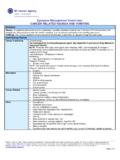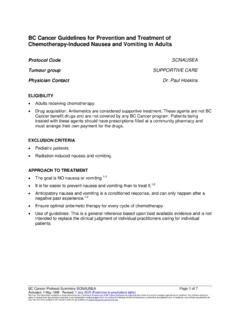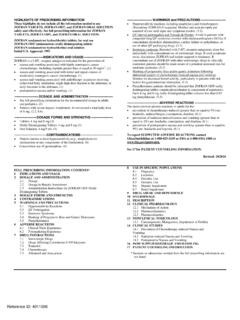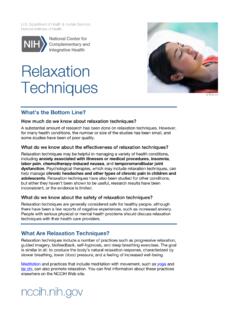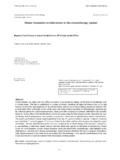Transcription of DRUG NAME: Eribulin - BC Cancer
1 Eribulin BC Cancer Agency Cancer Drug Manual Page 1 of 6 Eribulin Developed: 1 January 2014 Revised: 1 February 2016, 1 April 2016 DRUG NAME: Eribulin SYNONYM(S): Eribulin mesylate COMMON TRADE NAME(S): HALAVEN CLASSIFICATION: antimicrotubule agent Special pediatric considerations are noted when applicable, otherwise adult provisions apply. MECHANISM OF ACTION: Eribulin is a non-taxane microtubule dynamics inhibitor, belonging to a new class of antineoplastic agents, the halichondrin class. Eribulin inhibits the formation of mitotic spindles and blocks cell cycle progression at the G2/M phase, resulting in apoptotic cell death.
2 However, unlike other antimicrotubule agents ( taxanes, vinca alkaloids), Eribulin inhibits the growth phase without affecting the microtubule shortening phase and also sequesters tubulin into nonfunctional aggregates, thereby exhibiting activity against taxane-resistant PHARMACOKINETICS: Distribution rapid cross blood brain barrier? no information found volume of distribution 43-114 L/m2 plasma protein binding 49-65% Metabolism negligible active metabolite(s) none inactive metabolite(s) none Excretion predominantly as unchanged drug urine2 9% feces2 82% terminal half life 40 h clearance L/h/m2 Adapted from standard reference1 unless specified otherwise.
3 USES: Primary uses: Other uses: *Breast Cancer *Health Canada approved indication SPECIAL PRECAUTIONS: Contraindications: history of hypersensitivity reaction to Eribulin or halichondrin B or its chemical derivatives1 congenital long QT/QTc syndrome1 Eribulin BC Cancer Agency Cancer Drug Manual Page 2 of 6 Eribulin Developed: 1 January 2014 Revised: 1 February 2016, 1 April 2016 Caution: QT/QTc interval prolongation has been observed with Eribulin . Baseline and periodic ECG and electrolyte monitoring are suggested in patients at risk for developing torsades de pointes, including those with cardiac disease, history of arrhythmias, electrolyte disturbances, nutritional deficits, and other risk factors for QT interval prolongation.
4 Concurrent therapy with other QT/QTc-prolonging drugs may increase the risk of potentially fatal arrhythmias and should be avoided if Correct electrolyte disturbances prior to treatment; use caution with drugs that may disrupt electrolyte Peripheral neuropathy has been observed with Eribulin ; use with caution in patients with pre-existing Consider dose reduction in mild to moderate hepatic1 or moderate renal impairment2; see Dosage Guidelines. Carcinogenicity: no information found. Mutagenicity: Not mutagenic in Ames test. Eribulin is mutagenic in a mammalian in vitro mutation test and clastogenic in a mammalian in vivo chromosome Fertility: Testicular toxicity has been reported in animals, including soft and/or small testes, decreased testicular weight, hypocellularity or degeneration of seminiferous tubules.
5 Testicular changes were associated with secondary epididymal hypospermia/aspermia. In rats, there is indication that testicular damage may be irreversible. Men are advised to conserve sperm prior to treatment with Eribulin if planning to father children in the Pregnancy: FDA Pregnancy Category There is positive evidence of human fetal risk, but the benefits from use in pregnant women may be acceptable despite the risk ( , if the drug is needed in a life-threatening situation or for a serious disease for which safer drugs cannot be used or are ineffective). Embryo-fetal toxicity and teratogenicity have been reported in animal studies, at doses less than human recommended doses.
6 Decreased fetal weight, external and/or soft tissue anomalies (absence of lower jaw, tongue, stomach and spleen) and early delivery have been As a microtubule inhibitor, Eribulin is expected to cause fetal harm when administered to pregnant women. Contraception is recommended during treatment and for at least 3 months after Breastfeeding is not recommended due to the potential secretion into breast milk. SIDE EFFECTS: The table includes adverse events that presented during drug treatment but may not necessarily have a causal relationship with the drug. Because clinical trials are conducted under very specific conditions, the adverse event rates observed may not reflect the rates observed in clinical practice.
7 Adverse events are generally included if they were reported in more than 1% of patients in the product monograph or pivotal trials, and/or determined to be clinically ORGAN SITE SIDE EFFECT Clinically important side effects are in bold, italics blood and lymphatic system/ febrile neutropenia anemia (58-78%, severe <1-2%)1,2 febrile neutropenia (5%) neutropenia (82%, severe 29%); nadir 13 days, recovery 8 days thrombocytopenia (20%, severe 1%) cardiac QT-interval prolongation tachycardia (3-10%) ear and labyrinth vertigo (3-10%) gastrointestinal emetogenic potential: low6 abdominal pain (1-10%)1,2 Eribulin BC Cancer Agency Cancer Drug Manual Page 3 of 6 Eribulin Developed: 1 January 2014 Revised.
8 1 February 2016, 1 April 2016 ORGAN SITE SIDE EFFECT Clinically important side effects are in bold, italics stomatitis, mucosal inflammation (5-18%)1,2 constipation (25%, severe <1%) diarrhea (18%) nausea (35%, severe <1%) pancreatitis (<1%) vomiting (18%, severe 1%) general disorders and administration site conditions extravasation hazard: none asthenia/fatigue (54%, severe 1-9%) peripheral edema (1-10%)1,2 pyrexia (21%, severe <1%) urinary tract infection, upper respiratory tract infection (1-10%)1,2 investigations ALT increase (3-18%)1,2 AST increase (3 -10%) bilirubin abnormality (3%, severe 1%) creatinine abnormality (3%, severe 1%) weight loss (21%, severe 1%) metabolism and nutrition anorexia (20%, severe 1%) hypercalcemia/hypocalcemia (4-7%, severe 1-2%) hyperkalemia/hypokalemia (3-10%, severe 1-4%) hypermagnesemia/hypomagnesemia (3-10%, severe 1-4%)) musculoskeletal and connective tissue arthralgia/myalgia (22%, severe <1%) back and limb pain (11-16%)
9 Bone pain (12%, severe 2%) nervous system dizziness (1 -10%)1,2 headache (10-19%, severe <1%)1,2 peripheral neuropathy (35%, severe 8%) psychiatric anxiety (3-10%) depression, insomnia (1-10%)1,2 respiratory, thoracic and mediastinal cough (14%) dyspnea (16%, severe 1-4%) skin and subcutaneous tissue alopecia (45%) pruritus (3-10%) rash (1-10%)1,2 vascular hypertension (3 -10%) Adapted from standard reference1 unless specified otherwise. INTERACTIONS: Avoid concurrent use of QT/QTc-prolonging drugs if possible. ECG monitoring is recommended. Use caution with drugs that may disrupt electrolyte Eribulin BC Cancer Agency Cancer Drug Manual Page 4 of 6 Eribulin Developed: 1 January 2014 Revised: 1 February 2016, 1 April 2016 SUPPLY AND STORAGE: Injection: Eisai Limited supplies Eribulin injection as 1 mg single use, ready-to-use vials in a concentration of Vials contains 5% (v/v) dehydrated alcohol.
10 Store at room temperature. Do NOT freeze. Protect from For basic information on the current brand used at the BC Cancer Agency, see chemotherapy Preparation and Stability Chart in Appendix. SOLUTION PREPARATION AND COMPATIBILITY: For basic information on the current brand used at the BC Cancer Agency, see chemotherapy Preparation and Stability Chart in Appendix. Additional information: Do not dilute with or administer through an intravenous line containing dextrose May be administered undiluted or diluted in up to 100 mL Compatibility: consult detailed reference PARENTERAL ADMINISTRATION: BCCA administration guideline noted in bold, italics Subcutaneous no information found Intramuscular no information found Direct intravenous administer over 2 to 5 minutes1,7 Intermittent infusion administer over 2 to 5 minutes1.










